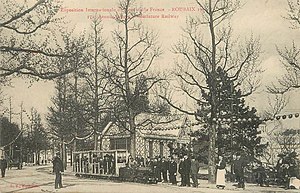Miniature Railway of the Exposition Internationale du Nord de la France
| Miniature Railway at Roubaix Exposition Internationale du Nord de la France , 1911 |
|
|---|---|
|
The Miniature Railway of the Exposition Internationale
du Nord de la France in Roubaix , 1911 The Miniature Railway of the Exposition Internationale du Nord de la France  | |
| Gauge : | 381 mm ( Liliputbahn ) |
The Miniature Railway of the Exposition Internationale du Nord de la France in Roubaix was a park railway operated by a steam locomotive in 1911 with a track gauge of 381 mm (15 inches ).
history
The International Exhibition of Northern France took place in Roubaix from April 30th to November 6th, 1911. Two years before the exhibition, the Roubaix City Council, headed by Eugène Motte, decided on March 19, 1909 that the municipality should take part in an international event. This event, which took place in and around Barbieux Park, was intended to demonstrate the supremacy of the city of Roubaix in the field of textile production and show that “capital” and “work” can coexist. It took place at the height of the economic development of Roubaix, which a few years later was completely ruined by the First World War.
The organizers addressed the regular guests of large exhibitions, in particular industrial companies and chambers of commerce from the colonies and from other European and international countries. Six countries were officially represented: Italy, Argentina, Belgium, the Netherlands, Australia and New Zealand. There were various pavilions on the site. B. the colonies, the new professions and techniques, the nations, but also those of the Red Cross. Numerous attractions should attract and seduce visitors: a French restaurant, a Flemish village, a Senegalese village, an amusement park called Luna Park , a casino, an exhibition of modern art, a stadium, right up to a small airfield on the nearby land.
Access to the exhibition was through a monumental portal at the end of Boulevard de Paris (today Boulevard De Gaulle). A total of 3300-3500 exhibitors were represented at the fair. According to various reports, the event drew between 800,000 and 1,700,000 visitors from all over France, but also from neighboring Belgium and Great Britain.
Route
The narrow-gauge railway ran along Avenue Le Nôtre and Avenue Jussieu .
locomotive
When the locomotive it could well be a manufacturer in Cologne , Wroclaw and Budapest used Liliput -Lokomotive that of Wenman Joseph Bassett-Lowke based company Miniature Railways of Great Britain Ltd in Northampton . She was an Atlantic - Tender - steam locomotives with the wheel arrangement 2'B1 ', ie with a leading end bogie , two driving axles and a carrying axle , the mobile in the frame was mounted.
Scénic Railway
The Scénic Railway was a wooden roller coaster in the Lunapark (Parc de Attractions) at the same exhibition.
The Scénic Railway in the Roubaix Lunapark
See also
Individual evidence
- ↑ Exposition Internationale du Nord de la France, Roubaix, 1911.
- ^ Hubert Ledoux: La cité de laine à l'apogée de sa puissance. Cent ans de vie dans la région, Volume 1, 1900-1914: Un train d'enfer, La Voix du Nord, November 17, 1998, pp. 82-84.
- ^ Robert Vandenbussche: Les grands événements du Nord de 1900 à nos jours. De Borée, 2014. ISBN 978-2812909900 . Pp. 52-53.
- ↑ Exposition Internationale de Roubaix 1911.
- ^ Philippe Waret: Chroniques de l'Exposition Internationale du Nord de la France Roubaix 1911.
- ^ Brighton Toy and Model Museum: The Bassett-Lowke Story, by Roland Fuller.
- ^ Roland Fuller: The Bassett-Lowke Story.
- ^ Luna Park, la perle de l'Exposition, le Scénic Railway, Laffineur-Samin, Collotype, 1911, Exposition Internationale reimagined.
Coordinates: 50 ° 40 ′ 41.1 ″ N , 3 ° 9 ′ 48.7 ″ E




